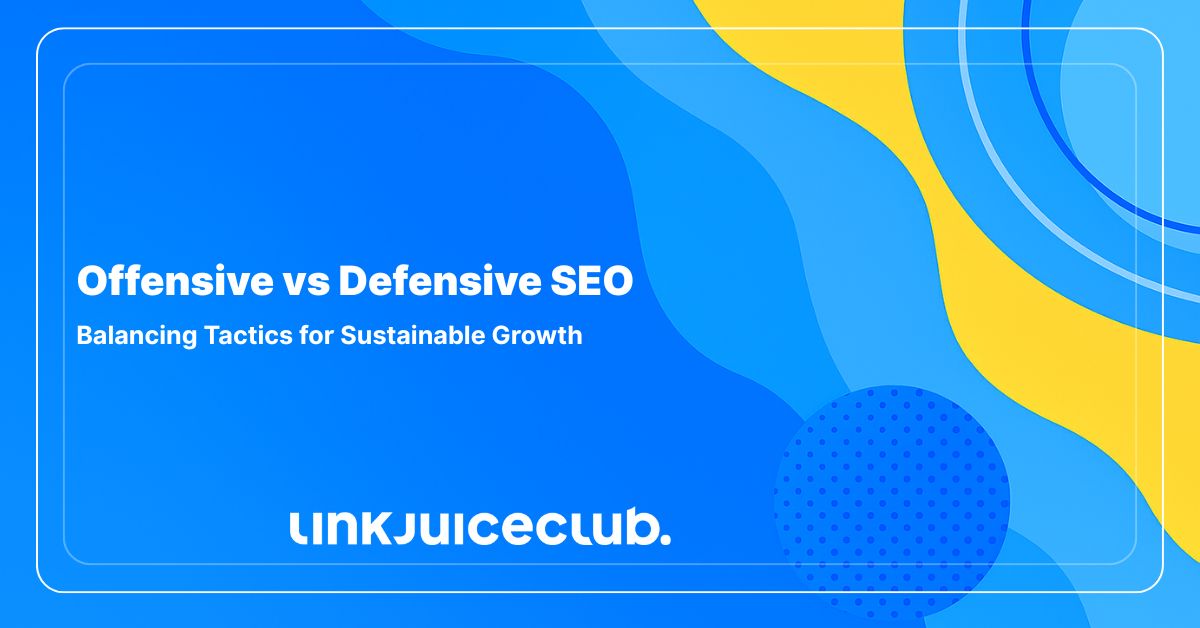
Offensive vs Defensive SEO: Balancing Tactics for Sustainable Growth
Success in SEO doesn’t come from a single tactic or one-time fix. It’s the balance between protecting the ground you’ve already won and pushing into new territory.
Think of it like a sports strategy: defense keeps you in the game, but offense is what helps you win. In the same way, businesses need defensive SEO to safeguard rankings and offensive SEO to capture new opportunities.
Understanding Offensive and Defensive SEO
Search engine optimization isn’t static. Google evaluates websites using more than 200 ranking factors, and its algorithms evolve constantly. For small business owners, staying across every update is nearly impossible while also managing daily operations. That’s why thinking of SEO in two broad categories — offensive and defensive — can simplify decision-making.

Defensive SEO focuses on maintaining and protecting the rankings you already have. Offensive SEO, by contrast, is about growth: targeting new keywords, publishing fresh content, and building authority to expand visibility. A well-rounded strategy blends both. Without defensive measures, rankings erode. Without offensive initiatives, growth stalls.
Defensive SEO: Protecting What You’ve Built
Defensive SEO tactics keep your website healthy, stable, and aligned with Google’s best practices. These are the foundational tasks that prevent rankings from slipping.
Prioritizing Site Health
Your site must meet technical standards to even be eligible for strong rankings. Speed, mobile responsiveness, secure connections (HTTPS), and error-free navigation are non-negotiables. A site that loads slowly, breaks on mobile, or fails security checks will struggle to appear in search results.
Optimizing Existing Content
Defensive SEO isn’t just technical. It also involves revisiting existing pages and blog posts. Refreshing outdated information, tightening formatting, and improving metadata help preserve rankings and improve user experience. Small tweaks can stop gradual declines.
Regular Audits and Monitoring
Consistent tracking of keyword positions, crawl reports, and competitor performance helps identify problems early. Audits reveal broken links, duplicate content, and other issues that can quietly harm rankings if left unchecked.
In short, defensive SEO is about resilience. It ensures the foundation is strong so new growth efforts aren’t wasted on a shaky platform.
Offensive SEO: Driving New Growth
Offensive SEO looks forward. It’s about expanding reach and capturing new search opportunities.
Targeting New Keywords
Growth comes from increasing the number of terms your website ranks for. This requires keyword research to identify gaps, opportunities, and competitor blind spots. Offensive strategies focus on long-tail keywords, emerging trends, and intent-driven terms.
Publishing Fresh Content
Adding new blog posts, landing pages, or resource hubs creates fresh opportunities to rank. Importantly, this is additive — not replacing old pages, but expanding your site’s footprint. More content means more entry points for users and more signals for search engines.
Building Authority With Backlinks
Links remain one of Google’s strongest ranking signals. Offensive SEO campaigns often prioritize outreach, partnerships, and PR-driven link building. Earning mentions from credible sources strengthens authority and helps new content rank faster.
An offensive approach is about momentum. It’s how small businesses grow beyond their current visibility and compete with larger brands.
Warning Signs of Unbalanced SEO
Not every SEO provider blends offense and defense. Some focus heavily on technical fixes while ignoring growth, while others churn out content without securing the foundation. Warning signs include:
- No new content being published or updated.
- Old, slow, or outdated site performance issues ignored.
- Blog posts or landing pages uploaded without review or approval.
- Articles that feel irrelevant, fluffy, or poorly written.
- Reports limited to traffic or rankings without context.
A provider delivering only defensive SEO may help you hold your ground — but not expand. A provider delivering only offensive SEO risks growth collapsing if the site’s technical health fails. Both sides matter.
Building a Balanced SEO Strategy
An effective strategy blends defensive and offensive tactics in tandem.
Defend Rankings While You Grow
Ongoing audits, metadata updates, fixing 404 errors, and improving site speed preserve current rankings. Meanwhile, keyword research and content creation open new opportunities. These dual efforts reinforce each other: defensive stability allows offensive campaigns to succeed.
Look Beyond Maintenance
Optimizing existing pages helps retain positions, but it won’t significantly increase traffic volume. Offensive initiatives — new blogs, new landing pages, new backlink campaigns — expand reach and visibility.
Compete Strategically
Ask your provider how they identify new keyword opportunities and how your content compares to competitors. Their answers should show both defensive awareness (site health) and offensive ambition (growth planning).
Proactive SEO Tactics You Can Apply
Not everything needs to wait for an agency. Business owners can take proactive steps to support both offensive and defensive SEO.
Use Smart Copywriting
Write content that answers questions, solves problems, and integrates keywords naturally. High-quality copy keeps readers engaged and improves your chances of ranking.
Invest in Local SEO
For businesses targeting specific markets like Brisbane, claim and optimize your Google Business Profile, encourage reviews, and integrate local terms into your content. Local signals boost visibility in map packs and nearby searches.
Build Quality Backlinks
List your business in reputable directories, guest post on industry blogs, or collaborate with partners to earn credible links. These reinforce authority and drive new traffic.
Improve Technical Performance
Small adjustments like compressing images, enabling caching, or using plugins to optimize WordPress sites can significantly improve speed — a ranking and user experience factor.
Strengthen Metadata
Clear, keyword-rich title tags and meta descriptions boost click-through rates. These on-page tweaks make your listings more appealing in search results.
Monitor Analytics
Use Google Analytics and Search Console to track performance. Watch for pages that drop in traffic, identify high-performing keywords, and measure ROI from organic search.
Stay Updated
Google’s algorithm updates shift priorities. Staying informed — through industry blogs, webinars, or your provider — ensures you adapt quickly.
Why Both Sides Matter
Think of defensive SEO as your insurance policy and offensive SEO as your growth engine. One without the other leaves gaps:
- Rely only on defense, and your visibility stagnates.
- Focus only on offense, and technical weaknesses undermine growth.
A good provider — or internal SEO team — balances both, using audits and site health checks to protect rankings while simultaneously building content, backlinks, and authority to expand reach.
Partnering With Professionals
SEO can be overwhelming, and not every business has the time to manage both sides effectively. Partnering with a professional agency can make the difference between maintaining rankings and achieving sustainable growth.
At Link Juice Club, we combine keyword research, content calendars, and backlink strategies with routine audits and technical fixes. Each package balances offense and defense, with monthly reporting that tracks both site health and growth metrics. The result is a holistic approach where your site not only stays strong but also climbs.
Final Thoughts
Google rewards websites that are healthy, consistent, and continuously growing. That’s why offensive and defensive SEO tactics should never be seen as competing approaches — they are complementary. A truly effective strategy protects existing rankings, prevents erosion, and builds the foundation for growth while also pushing into new territory.
If your current SEO campaign feels one-sided, it may be time to reevaluate. Ask direct questions: How is site health being monitored? What new keyword opportunities are being targeted? How does reporting connect rankings to business outcomes?
Businesses that understand and balance both sides of SEO aren’t just maintaining visibility. They’re securing long-term growth in an increasingly competitive search landscape.





